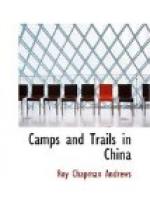Mr. Heller carried a 250-300 Savage rifle, while I used a 6-1/2 mm. Mannlicher and a .405 Winchester. All of these guns were eminently satisfactory, but the choice of a rifle is a very personal matter and every sportsman has his favorite weapon. We found, however, that a flat trajectory high-power rifle such as those with which we were armed was absolutely essential for many of our shots were at long range and we frequently killed gorals at three hundred yards or over.
The camera equipment consisted of two 3A Kodaks, a Graphic 4 x 5 tripod camera, and Graflex 4 x 5 for rapid work. We have found after considerable field experience that the 4 x 5 is the most convenient size to handle, for the plate is large enough and can be obtained more readily than any other in different parts of the world. The same applies to the 3A Kodak “post-card” size film, for there are few places where foreign goods are carried that 3A films cannot be purchased.
All of our plates and films were sealed in air-tight tin boxes before we left America, and thus the material was in perfect condition when the cans were opened. We used plates almost altogether in the finer photographic work, for although they are heavier and more difficult to handle than films, nevertheless the results obtained are very superior. A collapsible rubber dark room about seven feet high and four feet in diameter was an indispensable part of the camera equipment. This tent was made for us by the Abercrombie & Fitch Company, of New York, and could be hung from the limb of a tree or the rafters of a building and be ready for use in five minutes.
The motion pictures were taken with a Universal camera, and like all other negatives were developed in the field by means of a special apparatus which had been designed by Mr. Carl Akeley of the American Museum of Natural History. This work required a much larger space than that of the portable dark room and we consequently had a tent made of red cloth which could be tied inside of our ordinary sleeping tent.
Our equipment was packed in fiber army trunks and in wooden boxes with sliding tops. The latter arrangement is especially desirable in Yuen-nan, for the loads can be opened without being untied from the saddle, thus saving a considerable amount of time and trouble.
It was by no means an easy matter to get our supplies together, but the Lane & Crawford Company of Hongkong pushed the making and packing of our boxes in a remarkably efficient manner; as the manager of one of their departments expressed it, “the one way to hurry a Chinaman is to get more Chinamen,” and they put a small army at work upon our material, which was ready for shipment in just a week.
While in Hongkong we were joined by Wu Hung-tao, of Shanghai, who acted as interpreter and “head boy” as well as a general field manager of the expedition. He formerly had been in the employ of Mr. F. W. Gary, when the latter was Commissioner of Customs in Teng-yueh, Yuen-nan, and he was educated at the Anglo-Chinese College of Foochow. Wu proved to be the most efficient and trustworthy servant whom we have ever employed, and the success of our work was due in no small degree to his efforts.




